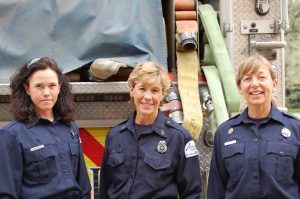The three women who make up Poudre Fire Authority’s only all-woman firefighting team all agree they’re on a good career path. Captain Teri Hergenrader and Firefighters Lou Abbott and Ellen Wright, the B shift for Station No. 12, wouldn’t trade it for anything.
“It combines a job that’s both helpful to others and it’s physically active,” Abbott says.

“It’s not sitting behind a desk eight hours a day,” Hergenrader adds. “Every day is different.”
They also admit that it’s demanding. The list of duties is long: responding to emergency calls that may include structure fires; wild land fires like the Hewlett and High Park fires; vehicle accidents and rescues; building inspections, looking for fire hazards and compliance with fire prevention ordinances; administering first-aid at an Emergency Medical Technician level; performing cardiopulmonary resuscitation and operating a semi-automatic external defibrillator; providing Haz-Mat response.
Then there’s the activity during a fire or other disaster. That involves not only operating the firefighting equipment, handling hoses, positioning and using ladders to enter buildings, but also assessing and responding to situations as they arise and, then, of course, dealing with the public.
PFA firefighters work a 24-hour rotating schedule, including holidays and weekends, and overtime and emergency call-ins as needed. “We work in big chunks but then we’re off in big chunks and we can trade time for something important,” Abbott says.
While on duty, they live at the fire station. Station No. 12 — just east of Terry Lake — has a kitchen, sleeping quarters and a TV room in addition to the computer/work space areas, and a workout facility. It has more equipment than some of the stations since it covers vastly different settings, Hergenrader says.
“Since we have wild lands, we have a brush unit for grass fires,” she explains. ”And we need the water tender to carry large amounts of water because we have areas without hydrants. Then, of course, we have our fire engine.”
The Station 12 crew responded to this summer’s Hewlett and High Park fires with the brush truck and the water tender, which drew water from the Poudre River to battle the blazes. They worked closely with personnel from the Poudre Canyon Fire Protection District, both as a crew and when assigned to other units individually.
The work setting can be calm, preparing reports or giving safety demonstrations to community groups, or can be challenging in hazardous environments and medical/trauma situations. For that reason, physical agility and strength are basic job requirements.
“You might have to lift or move 100 pounds while you’re wearing heavy protective clothing, and a breathing apparatus,” says Hergenrader. The hose weighs up to 150 pounds and many of the fire fighting tools weigh up to 80 pounds. Firefighters also have to be able to crouch, kneel, and crawl in a confined space.
The job also requires common sense and compassion. “We do see a lot of tragic things,” Hergenrader confirms. “Sometimes it can wear on you, but you stick with it and do what you’re supposed to do.”
“It helps to talk it over with coworkers because everyone in this business understands it,” Abbott says. “And we also have the Critical Incidence Debriefing process that people can use when needed.”
They all stress that firefighting is a good career choice for women. “Not too many women apply, but I’d encourage them to consider it,” Hergenrader says.
Firefighting wasn’t at the top of the list of what she wanted to do when she grew up.
“My dad was a volunteer firefighter and I never knew I could do this,” Herenrader recalls. ”Guys fought the fires and the moms made the dinner. I didn’t think about going into it until after I got out of college and I was teaching physical education.”
She worked a summer job putting in sprinklers and the rest of the crew were all firefighters. They encouraged her to take the fire academy entrance exam. She did and has spent the last 22 years in the job.
Abbott had always worked non-traditional jobs including UPS driver, construction, and as a seasonal employee for the Rocky Mountain National Park. She met the first PFA female firefighter Kris Linderholm 30 years ago; they became friends and Abbott started training. ”I didn’t think about (firefighting as a career) until I knew someone who was doing it,” Abbot says. She was hired 27 years ago.
Wright majored in exercise and sports sciences in college and, while working with PFA as an internship performing fitness evaluations, she found her career. That was 17 years ago.
The three were brought together as a crew not by design but through the normal process of creating fire teams.
The three say they work well together. “The camaraderie is another plus to this job,” Hergenreder says. “We live together two-thirds of our lives so we’re like a family and we’re definitely a team. Our lives can be in each others’ hands.”
An expansion of the Station 12 crew in July has added one more to the team. Keegan Specht, formerly a volunteer in Eaton, completed his fire academy training earlier this year, and now is just one of the “girls.”
Support Northern Colorado Journalism
Show your support for North Forty News by helping us produce more content. It's a kind and simple gesture that will help us continue to bring more content to you.
BONUS - Donors get a link in their receipt to sign up for our once-per-week instant text messaging alert. Get your e-copy of North Forty News the moment it is released!
Click to Donate

